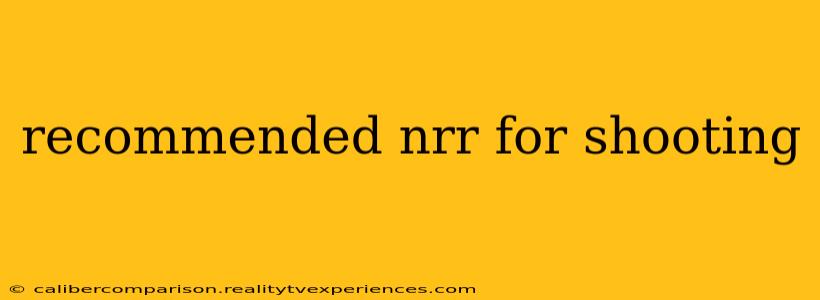Recommended NRR for Shooting: Finding the Sweet Spot for Your Needs
Choosing the right Noise Reduction Rating (NRR) for your shooting ear protection is crucial for preserving your hearing while enjoying the sport. The ideal NRR isn't a one-size-fits-all answer; it depends heavily on your specific shooting environment and the types of firearms you use. This guide will help you understand NRR and determine the appropriate level for your needs.
Understanding the Noise Reduction Rating (NRR)
The NRR is a standardized rating indicating the amount of noise reduction a hearing protector provides. It's expressed in decibels (dB). A higher NRR means more noise reduction. However, it's vital to remember that the NRR is a laboratory rating and doesn't always perfectly reflect real-world performance. Individual fit and environmental factors play a significant role in the actual noise reduction experienced.
Factors Influencing Your NRR Choice
Several factors influence the optimal NRR for your shooting activities:
-
Firearm Type: High-powered rifles generate significantly more noise than handguns or low-powered shotguns. Using a high-powered rifle demands a higher NRR to protect your hearing effectively.
-
Shooting Environment: An outdoor range with open space will offer some natural sound dampening, compared to an indoor range, which can amplify sound. Indoor ranges require higher NRR protection.
-
Frequency of Shooting: If you shoot frequently, prioritizing hearing protection with a higher NRR is paramount. Consistent exposure to loud noises increases the risk of hearing damage over time.
-
Personal Comfort: While a higher NRR offers more protection, overly bulky or uncomfortable earmuffs or earplugs may lead to improper fit and reduced effectiveness. Finding a balance between protection and comfort is crucial.
Recommended NRR Levels: A Practical Guide
While there's no universally perfect NRR, here's a guideline based on common shooting scenarios:
-
Handguns & Low-Powered Shotguns (occasional shooting): An NRR of 22-25 dB might suffice for occasional shooting with these firearms. However, always prioritize a proper fit for maximum protection.
-
High-Powered Rifles & Frequent Shooting: For high-powered rifles or frequent shooting sessions, an NRR of 28 dB or higher is strongly recommended. Consider earmuffs with a higher NRR (e.g., 30 dB or above) for optimal protection.
-
Indoor Ranges: The amplified sound in indoor ranges necessitates a higher NRR. Aim for at least 28 dB, and consider earmuffs with an NRR exceeding 30 dB for superior protection.
Beyond the NRR: Choosing the Right Hearing Protection
The NRR is just one aspect to consider. Other crucial factors include:
-
Comfort and Fit: A poorly fitting hearing protector, regardless of its NRR, will be ineffective. Ensure the earmuffs or earplugs fit snugly and comfortably for optimal noise reduction.
-
Maintenance: Regular cleaning and maintenance are crucial for prolonging the life and effectiveness of your hearing protection.
-
Type of Hearing Protector: Consider both earmuffs and earplugs; some shooters prefer a combination of both for superior protection. Earmuffs offer better overall protection, especially against blast overpressure, while earplugs provide a more discreet option.
Conclusion: Prioritizing Hearing Health
Protecting your hearing is paramount. Choosing the right NRR for your shooting ear protection is a crucial step in preventing hearing damage. Carefully consider the factors outlined above, prioritize a proper fit, and always select hearing protection that provides sufficient noise reduction for your specific shooting activities. Remember that a higher NRR doesn't guarantee perfect protection—consistent use and a good fit are equally essential for safeguarding your hearing health.

